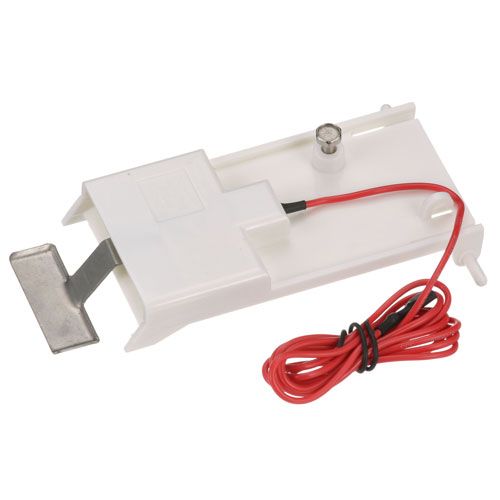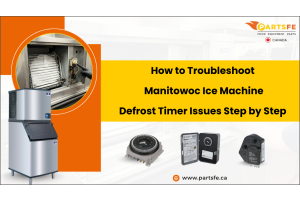How to Troubleshoot Common Issues with Manitowoc Ice Machines
Manitowoc ice machines are renowned for their reliability and efficiency in providing a consistent supply of high-quality ice, making them indispensable in commercial settings such as restaurants, bars, hotels, and healthcare facilities. However, Manitowoc ice machines may encounter occasional issues that can disrupt ice production and performance like any complex appliance. Timely troubleshooting of these common issues can help ensure minimal downtime and maintain a steady flow of ice for your business needs.
Overview Of Manitowoc Ice Machines: Types And Applications
Manitowoc Ice is a leading manufacturer of commercial ice machines, recognized for producing high-quality, innovative, and reliable ice-making equipment. Manitowoc's range of ice machines encompasses various types to cater to the diverse needs of commercial establishments, including restaurants, hotels, bars, healthcare facilities, and more.
Common types of Manitowoc ice machines
-
Modular ice machines: Modular ice machines are designed to produce large quantities of ice and are typically paired with a separate ice storage bin or dispenser. These machines are ideal for high-demand settings where a continuous and substantial supply of ice is essential, such as large-scale food and beverage operations or facilities with fluctuating ice needs.
-
Undercounter ice machines: Undercounter ice machines are compact and designed to fit conveniently beneath standard-height counters. These machines are suitable for establishments with limited space, such as small bars, coffee shops, or office break rooms, where a moderate ice production capacity is required without occupying valuable floor space.
-
Countertop ice machines: Countertop ice machines are specifically designed to sit atop a counter or another flat surface, offering a convenient, space-saving solution for producing and dispensing ice. These machines are often used in self-service beverage stations, small cafes, or healthcare facilities where space efficiency and ease of access are prioritized.
Common Replacement Parts For Manitowoc Ice Machines
|
Replacement Part |
Function |
|
Water pump |
Circulates water through the ice machine for consistent flow over the evaporator plate. |
|
Water inlet valve |
Controls water flow into the ice machine; regulates water supply for ice production. |
|
Water filtration components |
Filters, cartridges, and heads maintain water quality and prevent mineral buildup. |
|
Ice thickness probe |
Monitors ice formation; and ensures ice cubes are of the correct size and shape. |
|
Condenser fan motor |
Maintains optimal operating temperatures; prevents overheating and ensures efficiency. |
|
Ice machine control board |
Regulates ice-making processes including water intake, freezing, and harvest cycles. |
|
Evaporator plate |
Freezes water into ice cubes; requires replacement due to wear, corrosion, or damage. |
|
Ice bin components |
Thermostats, control boards, and gaskets for proper ice storage, dispensing, and quality maintenance. |
|
Water distribution tube and nozzle |
Ensures even water distribution over the evaporator plate for uniform ice formation. |
|
Harvest assist solenoid |
Assists in releasing ice from the evaporator plate during harvest cycles for efficient ice removal. |
Common Issues With Manitowoc Ice Machines
-
Low ice production: Reduced ice output can be caused by factors such as a dirty condenser, water supply issues, malfunctioning components like water pumps or sensors, or improper settings.
-
Ice quality problems: Issues like small or hollow ice cubes, cloudy ice, or off-flavors can result from mineral buildup, water impurities, improper water filtration, or problems with the ice-making process.
-
Ice machine leaks: Water leaks can occur due to damaged water lines, loose connections, ice buildup in the bin, or issues with the water inlet valve or water pump.
-
Ice machine not turning on: This may be due to power supply issues, a malfunctioning control board, faulty wiring, or internal component failures preventing the machine from powering up.
-
Ice machine freezing up: Excessive ice buildup on components like the evaporator plate, water distribution system, or sensors can lead to freezing issues, reduced efficiency, and potentially damage the machine.
-
Noise or vibrations: Unusual sounds or vibrations can indicate problems with the compressor, condenser fan motor, water pump, or other moving parts that may require maintenance or repairs.
-
Error codes displayed: Error codes on the control panel can signal specific issues such as high water levels, sensor malfunctions, temperature problems, or system errors that need to be addressed.
-
Slow harvest cycles: Delayed or inefficient ice harvest cycles can stem from issues with the harvest assist mechanism, ice thickness probe, control board, or improper settings affecting the harvest process.
-
Overheating: Overheating in the machine can result from an obstructed condenser, inadequate ventilation, a malfunctioning fan motor, or other factors affecting the cooling system.
-
Electrical problems: Issues like electrical shorts, faulty wiring, blown fuses, or power surges can disrupt the operation of the ice machine and require attention from a qualified technician.
Resetting Manitowoc Ice Machines
-
Turn off the machine: Ensure the ice machine is turned off using the power switch or by unplugging it from the power source.
-
Wait for a few minutes: Allow the ice machine to sit idle for several minutes to ensure all components have powered down completely.
-
Locate the reset button: Find the reset button on the control panel or inside the machine. Refer to the user manual for its specific location.
-
Press and hold the reset button: Press and hold the reset button for 10-15 seconds to clear any error codes or faults and reset internal settings.
-
Power on the machine: After releasing the reset button, turn the ice machine back on by flipping the power switch or plugging it in.
-
Monitor operation: Watch the ice machine closely to ensure it resumes normal operation without any unusual sounds or issues.
-
Verify ice production: Allow the machine to complete an ice-making cycle and check the quantity and quality of ice produced to confirm reset success.
Keeping Manitowoc Ice Machines In Off-Mode
-
Locate the power switch or controls for the Manitowoc ice machine.
-
Switch the machine to the "Off" position or press the designated power-off button.
-
Ensure that the machine remains disconnected from the power source, either by unplugging it or using a dedicated electrical disconnect switch if available.
-
If the machine has a control panel, ensure any control switches or buttons are also set to the "Off" position.
Turning On Manitowoc Ice Machines
-
Ensure the machine is properly connected to a power source.
-
Locate the power switch or controls for the Manitowoc ice machine.
-
Switch the machine to the "On" position or press the designated power-on button.
-
If the machine has a control panel, set any necessary controls or switches to the desired settings for ice production.
-
Wait for the machine to power up and initiate the ice-making process.
-
Monitor the machine for normal operation, ensuring that it begins producing ice as expected.
Tips For Maintaining Manitowoc Ice Machines
|
Maintenance task |
Description |
|
Regular cleaning |
Clean the ice machine regularly following the manufacturer's guidelines, including cleaning the evaporator, water distribution components, and bin interiors to prevent mineral buildup and mold growth. |
|
Check water filters |
Replace water filters at the recommended intervals to ensure water quality and prevent mineral deposits that can affect ice quality and machine performance. |
|
Monitor ice production |
Regularly check the ice production levels and quality. An unexpected decrease in production or changes in ice quality may indicate a problem that needs attention. |
|
Inspect seals and gaskets |
Check door seals and gaskets for wear and tear. Damaged seals can lead to air leaks, affecting ice production efficiency. |
|
Maintain proper clearances |
Ensure that the ice machine has adequate space around it for ventilation. Proper airflow helps regulate machine temperature and efficiency. |
|
Check water supply |
Monitor the water supply for consistent pressure and temperature. Inconsistent water conditions can impact ice production and quality. |
Regular maintenance, including cleaning, sanitizing, and inspecting key components, is crucial for preventing common problems and extending the lifespan of Manitowoc ice machines. Additionally, paying attention to water quality, proper installation, and adherence to manufacturer guidelines can help mitigate potential issues. When troubleshooting problems with Manitowoc ice machines, it's important to refer to the manufacturer's documentation, seek professional assistance when necessary, and follow safety protocols. Addressing issues promptly can prevent downtime, minimize the risk of costly repairs, and ensure that the ice machine continues to meet the demands of commercial and industrial applications. PartsFe.Ca offers a wide selection of ice machine parts from reputable manufacturers like Manitowoc and Ice O Matic. Get the best quality replacement parts and accessories for all your ice machine needs now.
FAQs
Why is my Manitowoc ice machine producing less ice than usual?
Factors like a dirty condenser, water supply issues, malfunctioning components, or improper settings can cause low ice production. Try cleaning the unit, checking the water supply, and inspecting components for any problems.
How can I address cloudy or soft ice cubes from my Manitowoc ice machine?
Cloudy or soft ice cubes can result from mineral buildup or water impurities. Consider cleaning the machine, checking water filtration, and ensuring proper water quality.
What should I do if my Manitowoc ice machine is leaking water?
Water leaks can stem from damaged water lines, loose connections, or internal issues. Inspect the machine for leaks, tighten connections, and address any damaged parts promptly.












